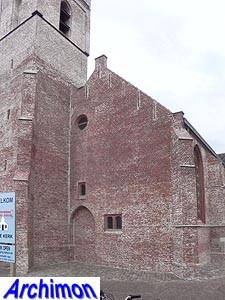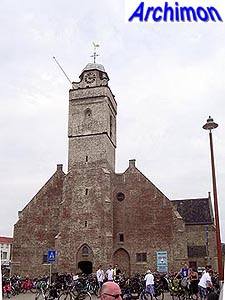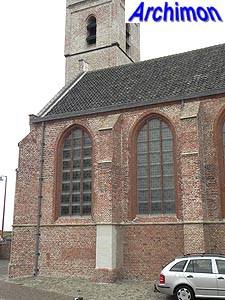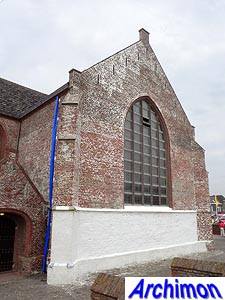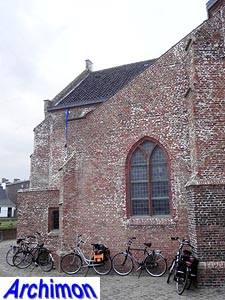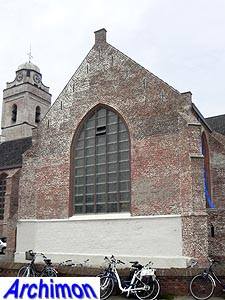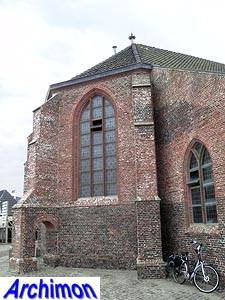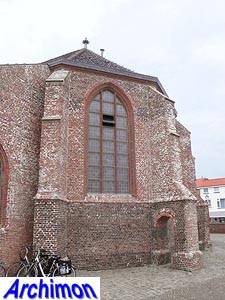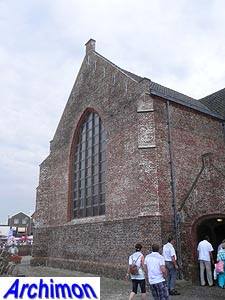
Katwijk aan Zee (ZH): reformed Oude of Andreaskerk
 The
history of Katwijk aan Zee began in the the late 13th century,
with the construction of a chapel. In 1461 the village became a parish
and the chapel was replaced by a three-aisled cruciform church with a
slim tower, all in Gothic style. In 1571 protestant pirates
looted the church. A year
later it was set on fire by Spanish troops, destroying the roof and the
upper parts of
the walls. After the Reformation the church was not repaired
immediately; instead the protestant community attended the church in
Katwijk aande Rijn. In 1599 it was decided that the two villages would
be seperated again. The southern part of the church of Katwijk aan Zee
was now rebuiltto serve as a protestant church
: half the nave and incorporating the southern
side-aisle.
A wall was built right through the original nave and the resulting
church was covered with a new saddle roof. The northern half as well as
the transept and the choir remained as ruins for a long time.
In
1709
the northern half was adapted in a similar fashion and the seperating
wall replaced by two pillars, resulting in the current
two-aisled
configuration. In 1836 a storm destroyed the spire of the tower, which
was subsequently replaced by an octagonal dome.
The
history of Katwijk aan Zee began in the the late 13th century,
with the construction of a chapel. In 1461 the village became a parish
and the chapel was replaced by a three-aisled cruciform church with a
slim tower, all in Gothic style. In 1571 protestant pirates
looted the church. A year
later it was set on fire by Spanish troops, destroying the roof and the
upper parts of
the walls. After the Reformation the church was not repaired
immediately; instead the protestant community attended the church in
Katwijk aande Rijn. In 1599 it was decided that the two villages would
be seperated again. The southern part of the church of Katwijk aan Zee
was now rebuiltto serve as a protestant church
: half the nave and incorporating the southern
side-aisle.
A wall was built right through the original nave and the resulting
church was covered with a new saddle roof. The northern half as well as
the transept and the choir remained as ruins for a long time.
In
1709
the northern half was adapted in a similar fashion and the seperating
wall replaced by two pillars, resulting in the current
two-aisled
configuration. In 1836 a storm destroyed the spire of the tower, which
was subsequently replaced by an octagonal dome.
In the
centuries
since the foundation of the chapel, the sea had taken large portions of
the coast and the church, once at the centre of the village, now lie at
its very edge, near the beach. Also, it had become too small.
In 1887 a new church was completed elsewhere in
the village, and the old church served as a storage house for
shipping equipment and salt until 1921. In 1923-1925 the building was
restored and enlarged with rebuilt transept, choir and
sacristy on
the old foundations; the strange proportions indicate that they were
now lower than they originally were.
After the restoration the building became a church again, the
other church having become too small as well.
In
1942, during the Second World War, the German army ordered the
demolition of the upper half of the tower. The rest of the church was
left alone. In 1952 the tower was rebuilt, although the
original
was not copied exactly.
Traditionally,
the church is painted white. These pictures were made in 2011, when the
walls of the church were being restored and the white coat had been
removed.

